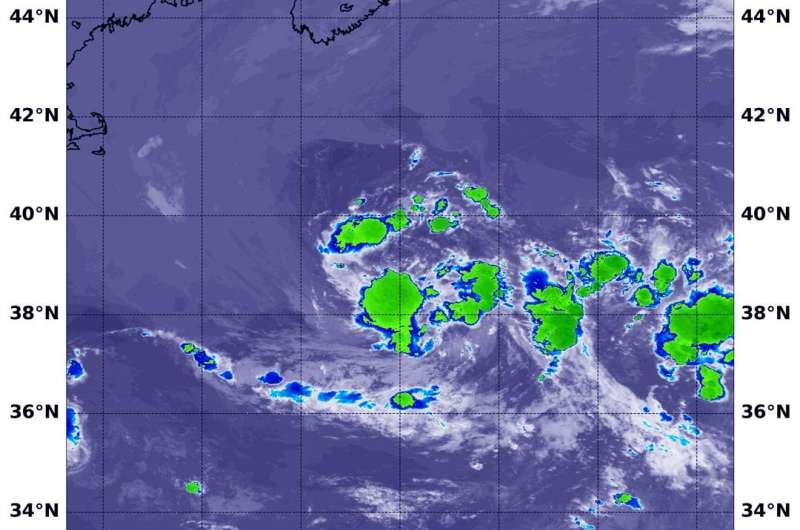NASA analyzes the newest Atlantic Ocean subtropical depression

NASA's Aqua satellite used infrared light to analyze the strength of storms in the North Atlantic Ocean's newly formed Subtropical Depression 4. Infrared data provides temperature information to find the strongest thunderstorms that reach high into the atmosphere which have the coldest cloud top temperatures.
By 5 p.m. EDT on Monday, June 22, the non-tropical low-pressure system that the National Hurricane Center had been following for the past couple of days off the U.S. east coast had developed enough organized convection near the center to be classified as subtropical depression. It was then that Subtropical Depression 4 was born.
The Moderate Resolution Imaging Spectroradiometer or MODIS instrument aboard NASA's Aqua satellite captured infrared data on June 23 at 2:10 a.m. EDT (0610 UTC). The MODIS data showed several fragmented and disorganized thunderstorms circling the center of circulation where cloud top temperatures as cold as or colder than minus 50 degrees Fahrenheit (minus 45.5 Celsius). Cloud top temperatures that cold indicate strong storms with the potential to generate heavy rainfall.
Just three hours after the MODIS image, at 5 a.m. EDT as daylight broke, NOAA's National Hurricane Center (NHC) said satellite data showed an increase in deep convection (rising air that forms the thunderstorms that make up tropical cyclones) since the Aqua satellite passed overhead. Those thunderstorms still appeared disorganized in this image.
NHC said, "The depression is situated beneath an upper-level low [pressure area], and the system has a large radius-of-maximum winds, so it is still subtropical. While it is possible the depression could become a storm later today, rapidly cooling sea surface temperatures should cause the system to weaken on Wednesday [June 24]."
What is a Subtropical Storm?
NOAA's National Hurricane Center defines subtropical storms as "A non-frontal low-pressure system that has characteristics of both tropical and extratropical cyclones. Like tropical cyclones, they are non-frontal, synoptic-scale cyclones that originate over tropical or subtropical waters, and have a closed surface wind circulation about a well-defined center. In addition, they have organized moderate to deep convection, but lack a central dense overcast. Unlike tropical cyclones, subtropical cyclones derive a significant proportion of their energy from baroclinic sources, and are generally cold-core in the upper troposphere, often being associated with an upper-level low or trough. In comparison to tropical cyclones, these systems generally have a radius of maximum winds occurring relatively far from the center (usually greater than 60 nautical miles), and generally have a less symmetric wind field and distribution of convection.
Subtropical Depression 04L's Status
At 5 a.m. EDT (0900 UTC), on June 23 the center of Subtropical Depression Four was located near latitude 39.3 degrees north and longitude 63.4 degrees west. That is about 365 miles (590 km) south of Halifax, Nova Scotia, Canada.
The depression is moving toward the northeast near 13 mph (20 km/h), and this motion is expected to continue for next couple of days with some increase in forward speed. The estimated minimum central pressure is 1008 millibars. Maximum sustained winds are near 35 mph (55 kph) with higher gusts.
Little change in strength is forecast during the next day or so, with the system likely weakening and transitioning into a post-tropical cyclone on Wednesday, June 24.
What is a Post-tropical Cyclone?
NHC defines a post-tropical cyclone as a former tropical cyclone. This generic term describes a cyclone that no longer possesses sufficient tropical characteristics to be considered a tropical cyclone. Post-tropical cyclones can continue carrying heavy rains and high winds. Note that former tropical cyclones that have become extratropical, as well as remnant lows, are two classes of post-tropical cyclones.
Hurricanes/tropical cyclones are the most powerful weather events on Earth. NASA's expertise in space and scientific exploration contributes to essential services provided to the American people by other federal agencies, such as hurricane weather forecasting.
Provided by NASA's Goddard Space Flight Center


















